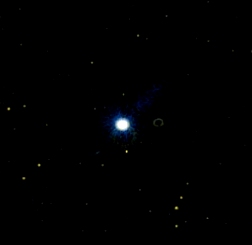
The constellation Ophiuchus is found in the midst of the
Serpens. The southern part of Ophiuchus dips into a very dense portion
of the Milky Way, resulting in a great many deep sky objects. The Bayer
stars of Ophiuchus are fairly bright, five of which have a magnitude
brighter than 3.0. The brightest star, alpha Ophiuchi, is better known
as Rasalhague, meaning "Head of the Snake Charmer". This is a rather
close star, at 54 light years away
In Star Trek, Ophiucus III is the third planet of the
Ophiucus system and a colony world that was being settled in the late
23rd century. Women were so scarce on the planet that intergalactic
rogue Harcourt Mudd saw an opportunity in bringing them in from other
worlds, to be sold as wives for the settlers. (TOS: "Mudd's Women")
In reality, Ophiuchus has a half-dozen or so visual
doubles, and even more star clusters. In fact Ophiuchus has more
globular clusters than any other constellation. The region encircling
rho Ophiuchi is also of some interest. This area contains several dark
clouds and nebulae that show the active formation of stars.
Barnard's Star is part of this constellation and the
most rapidly moving star relative to the solar system, with a proper
motion of 10.31". It is also the second closest star system to us, at a
distance of 5.91 light years. This is a red dwarf, with a visual
magnitude of only 9.5, and consequently not easily found. A slight
oscillation in both the right ascension and declination of Barnard's
Star has led observers to suggest the possibility that one or more
planets orbit the star.
|
